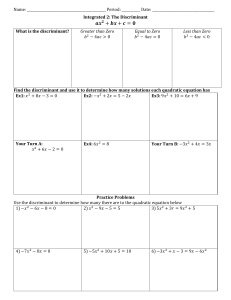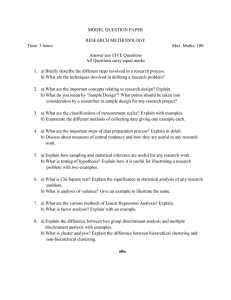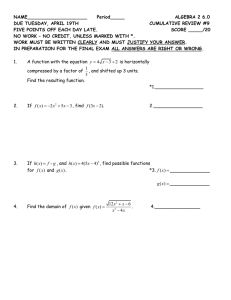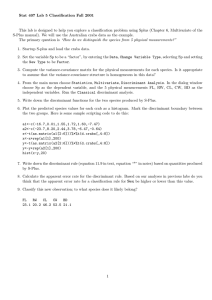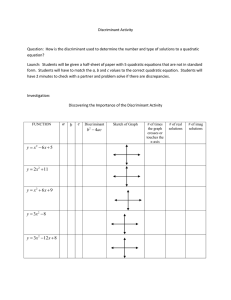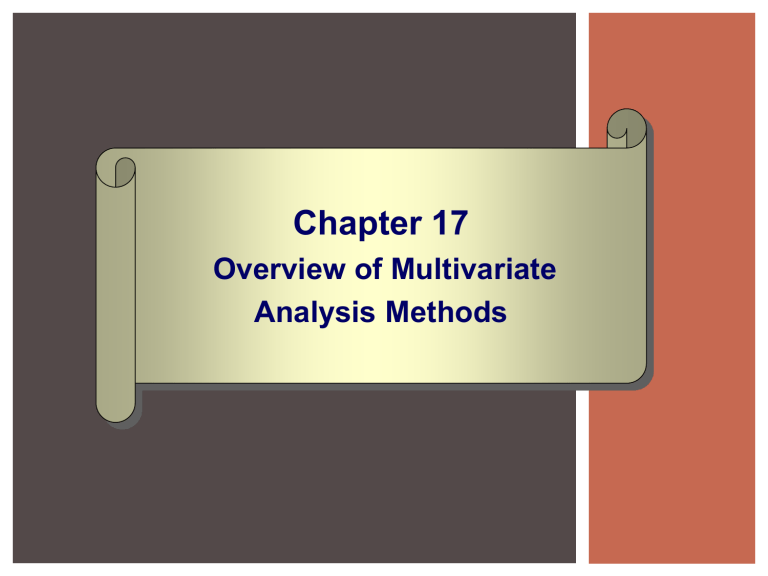
Chapter 17 Overview of Multivariate Analysis Methods MULTIVARIATE ANALYSIS statistical techniques used when there are multiple measurements of each element/concept and the variables are analyzed simultaneously. These techniques are important in marketing research because most business problems are multidimensional and can only be understood when multivariate techniques are used. 17-2 Classification of Multivariate Methods We’ve already discussed ANOVA, MANOVA, Correlation, Multiple Regression, and Perceptual Mapping. 17-3 Summary of Multivariate Methods 17-4 DEPENDENCE VS INTERDEPENDENCE METHODS Dependence – multivariate Interdependence – multivariate techniques appropriate when statistical techniques in which a one or more of the variables set of interdependent can be identified as relationships is examined – The dependent variables and the goal is grouping variables in remaining as independent some way. variables. Examples: multiple regression analysis, discriminant analysis, ANOVA and MANOVA Examples: factor analysis, cluster analysis, and multidimensional scaling. 17-5 FACTOR ANALYSIS . . . used to summarize information contained in a large number of variables into a smaller number of subsets or factors. Purpose – to simplify the data. Dependent and independent variables are analyzed separately, not together. All variables being examined are analyzed together – to identify underlying factors. 17-6 FACTOR ANALYSIS PROCESS Examine factor loadings & percentage of variance Steps Decide on number of factors Interpret & name factors 17-7 Factor Loadings are correlations between the variables and the new composite factor. These are the starting point for interpreting factor analysis. They measure the importance of each variable relative to each composite factor. Like correlations, factor loadings range from +1.0 to –1.0 Factor loadings are calculated between all factors and each of the original variables. 17-8 CLUSTER ANALYSIS classifies objects into relatively homogeneous groups based on the set of variables analyzed. classifies or segments objects into groups that are similar within groups and as different as possible across groups. identifies natural groupings or segments among many variables, does NOT include a dependent variable. 17-9 CLUSTER ANALYSIS 17-10 SPSS DIALOG BOX FOR CLUSTER ANALYSIS 17-11 CLUSTER ANALYSIS COEFFICIENTS Coefficients 17-12 NEW CLUSTER VARIABLE New cluster variable 17-13 DISCRIMINANT ANALYSIS It’s a dependence technique used for predicting group membership on the basis of two or more independent variables. Dependent variable – nonmetric or categorical (nominal or ordinal). Independent variables – metric (interval or ratio), but non-metric (nominal) dummy variables are possible. 17-14 DISCRIMINANT ANALYSIS Develops a linear combination of independent variables and uses it to predict group membership. Characteristics Predicts categorical dependent variable based on group differences using a combination of independent variables. Discriminant function – a linear combination of independent variables that bests discriminates between the dependent variable groups. 15 17-15 DISCRIMINANT ANALYSIS Discriminant Function Coefficients Estimates of the discriminatory power of a particular independent variable. Multipliers of variables in the discriminant function when variables are in the original units of measurement. 17-16 DISCRIMINANT ANALYSIS . The prediction is referred to as the hit ratio. . Shows the number of correctly and incorrectly classified cases . Classification (Prediction) Matrix – shows whether the estimated discriminant function is a good predictor. 17-17 DISCRIMINANT ANALYSIS SCATTER PLOT 17-18 SPSS DIALOG BOX FOR DISCRIMINANT ANALYSIS 17-19 SPSS DISCRIMINANT ANALYSIS OUTPUT 17-20 SPSS DISCRIMINANT ANALYSIS OUTPUT CONTINUED 17-21 Sample Conjoint Survey Profiles 17-22 Importance Calculations for Restaurant Data 17-23 Conjoint Part-Worth Estimates for Restaurant Survey 17-24
